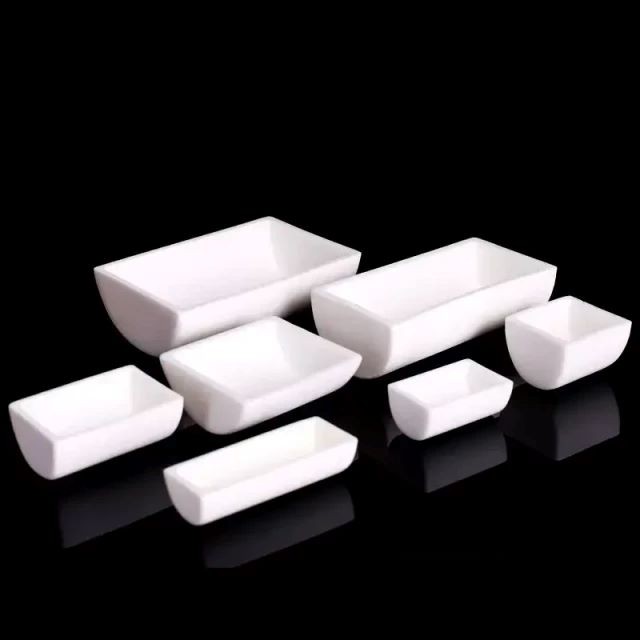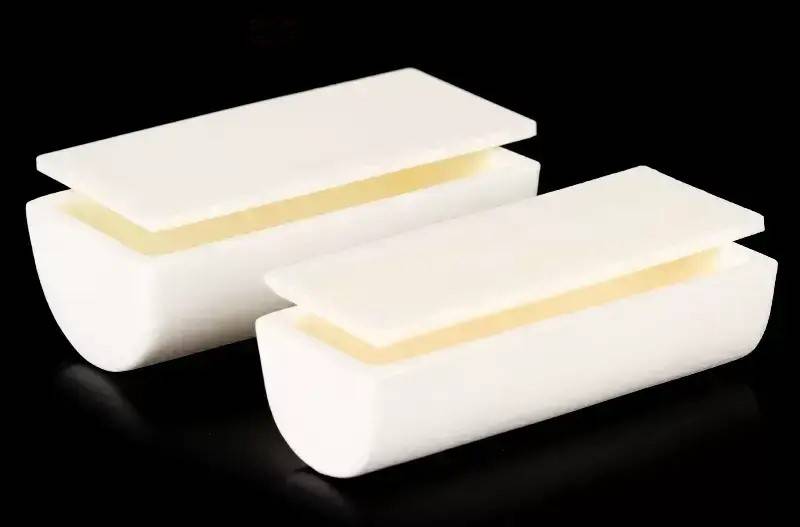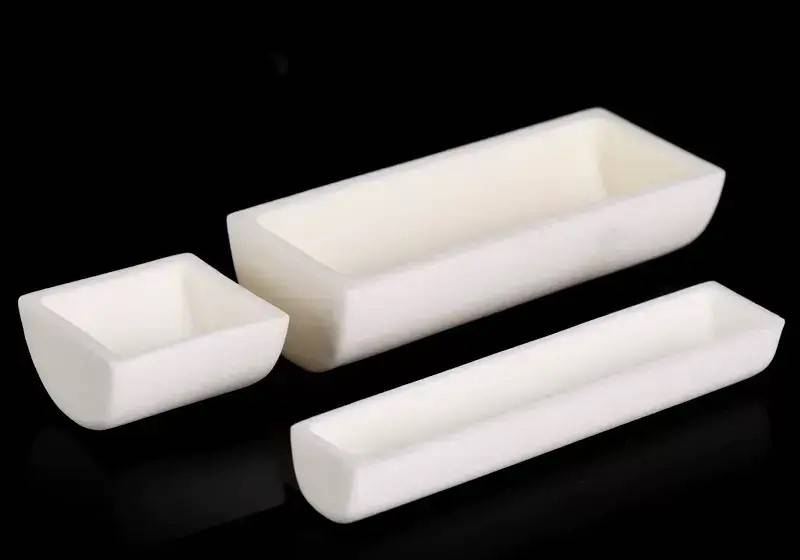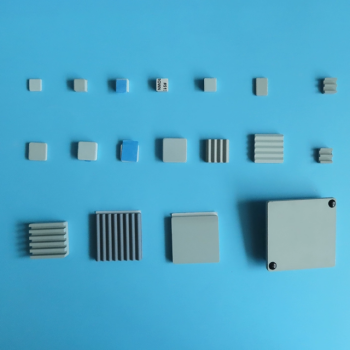
fine ceramics
Alumina Al2O3 Ceramic Crucible Semicircle Boat with Lid for Engineering Advanced Fine Ceramics
Item Number : KM-C03
Price varies based on specs and customizations
- Material
- Aluminum oxide
- Specification
- See the form
- Cover
- Optional
Shipping:
Contact us to get shipping details Enjoy On-time Dispatch Guarantee.
Why Choose Us
Reliable PartnerEasy ordering process, quality products, and dedicated support for your business success.
Application
Alumina ceramic crucibles are versatile and durable vessels for thermal analysis testing. Made of high-quality alumina ceramic, it has the characteristics of high melting point, strong hardness, good chemical stability, and can withstand extreme temperatures, corrosion and wear. Its smooth surface allows for easy sample removal, while its high thermal conductivity ensures accurate temperature readings during testing. It is a good material for high temperature resistance and chemical corrosion resistance. Alumina sample pans are widely used in thermal analysis such as DTA and DSC to provide consistent and precise results in thermal analysis tests.
Semicircle ceramic crucibles are usually non-porous, which means they do not absorb or retain liquids or gases. This feature helps prevent contamination and ensures accurate measurement or analysis when handling liquids or volatile substances.
- Material Testing: Alumina ceramic crucibles for precise thermogravimetric analysis.
- Metallurgical Processes: High-temperature and chemically resistant crucibles for smelting, casting, and refining metal alloys.
- Environmental Testing: Acid-resistant crucibles for accurate measurement of pollutants and toxins in soil and water samples.
- Drug Research: Crucibles used to analyze thermal properties of drug molecules, aiding in drug development.
- Ceramic and Glass Manufacturing: Crucibles designed to withstand extreme temperatures and thermal shock for molten glass and ceramic materials during production.
Detail & Parts





Technical specifications
Half round boat crucible (with cover / without cover)
| 5ml(40x25x17mm) | 17ml(55x35x22mm) | 42ml(100x40x25mm) | 97ml(250x40x19mm) | 9ml with lid (100x20x15mm) |
| 7ml(100x20x20mm) | 18ml(80x30x16mm) | 48ml(100x45x22mm) | 110ml(100x65x30mm) | 20ml with lid (100x30x20mm) |
| 10ml(65x25x16mm) | 20ml(100x30x20mm) | 58ml(60x55x40mm) | 1025ml(200x130x60mm) | 30ml with lid (100x35x18mm) |
| 30ml(100x35x18mm) | 60ml(150x40x20mm) | 700ml(150x150x60mm) | 40ml with lid (100x40x20mm) | |
| 9.5ml(38x34x19mm) | 40ml(60x54x24mm) | 65ml(100x50x30mm) | 800ml(180x120x45mm) | 42ml with lid (100x40x25mm) |
| 12ml(40x35x25mm) | 40ml(100x40x20mm) | 85ml(115x55x28mm) | 7ml with lid (100x20x20mm) | 65ml with lid (100x50x30mm) |
| 700ml with lid (150x150x60mm) |
The crucibles we show are available in different sizes and custom sizes are available on request.
Advantages
- High temperature resistance: long-term use at 1600°C, short-term use at 1800°C (Al2O3≥99%), suitable for melting, sintering, annealing and other occasions.
- Low Thermal Conductivity: Minimizes thermal shock for safe handling even when very hot.
- Superior Durability: Withstands multiple heating and cooling cycles without cracking or deforming.
- Easy to clean and cost-effective.
- Broad Material Compatibility: Compatible with metals, salts, organics and a wide variety of laboratory chemicals.
- Non-toxic, safe for laboratory use.
4.9
out of
5
Fantastic quality and value. I've used these crucibles in high-temperature experiments and they've held up perfectly.
4.9
out of
5
These crucibles are the best! They're durable, easy to clean, and perfect for my lab work.
4.9
out of
5
I'm very satisfied with these crucibles. They're well-made and have met all my expectations.
4.9
out of
5
These crucibles are a great value for the price. They're sturdy and have held up well in my experiments.
4.9
out of
5
I highly recommend these crucibles. They're high-quality and perfect for my lab's needs.
4.9
out of
5
These crucibles are simply amazing! They're durable, easy to use, and deliver accurate results.
4.9
out of
5
I'm thrilled with these crucibles. They're a great addition to my lab equipment.
4.9
out of
5
These crucibles are a lifesaver! They've made my lab work so much easier.
4.9
out of
5
I'm very impressed with these crucibles. They're well-made and perform exceptionally well.
4.9
out of
5
These crucibles are a game-changer for my lab. They're durable, accurate, and easy to clean.
4.9
out of
5
I'm incredibly satisfied with these crucibles. They're a great investment for any lab.
4.9
out of
5
These crucibles are top-notch! They're a must-have for any lab.
4.9
out of
5
I'm blown away by these crucibles. They're the perfect combination of quality and affordability.
4.9
out of
5
These crucibles are an absolute game-changer. They've made my lab work so much more efficient.
4.9
out of
5
I'm incredibly happy with these crucibles. They're a great addition to my lab equipment.
REQUEST A QUOTE
Our professional team will reply to you within one business day. Please feel free to contact us!
Related Products

Engineering Advanced Fine Ceramics Alumina Al2O3 Crucible With Lid Cylindrical Laboratory Crucible
Cylindrical Crucibles Cylindrical crucibles are one of the most common crucible shapes, suitable for melting and processing a wide variety of materials, and are easy to handle and clean.

Alumina ceramics have good electrical conductivity, mechanical strength and high temperature resistance, while zirconia ceramics are known for their high strength and high toughness and are widely used.

Alumina ceramic screws are fastening components made of 99.5% alumina, ideal for extreme applications requiring excellent thermal resistance, electrical insulation and chemical resistance.

In the journey of scientific exploration and industrial production, every detail is crucial. Our arc-shaped alumina ceramic crucibles, with their excellent high temperature resistance and stable chemical properties, have become a powerful assistant in laboratories and industrial fields. They are made of high-purity alumina materials and manufactured through precision processes to ensure excellent performance in extreme environments.

Alumina wear-resistant ceramic washer are used for heat dissipation, which can replace aluminum heat sinks, with high temperature resistance and high thermal conductivity.

High Temperature Alumina (Al2O3) Furnace Tube for Engineering Advanced Fine Ceramics
High temperature alumina furnace tube combines the advantages of high hardness of alumina, good chemical inertness and steel, and has excellent wear resistance, thermal shock resistance and mechanical shock resistance.

Engineering Advanced Fine Alumina Al2O3 Ceramic Crucible for Laboratory Muffle Furnace
Alumina ceramic crucibles are used in some materials and metal melting tools, and flat-bottomed crucibles are suitable for melting and processing larger batches of materials with better stability and uniformity.

Precision Machined Zirconia Ceramic Ball for Engineering Advanced Fine Ceramics
zirconia ceramic ball have the characteristics of high strength, high hardness, PPM wear level, high fracture toughness, good wear resistance, and high specific gravity.

Zirconia Ceramic Gasket Insulating Engineering Advanced Fine Ceramics
Zirconia insulating ceramic gasket has high melting point, high resistivity, low thermal expansion coefficient and other properties, making it an important high temperature resistant material, ceramic insulating material and ceramic sunscreen material.

Silicon Carbide (SIC) Ceramic Sheet Flat Corrugated Heat Sink for Engineering Advanced Fine Ceramics
Silicon carbide (sic) ceramic heat sink not only does not generate electromagnetic waves, but also can isolate electromagnetic waves and absorb part of electromagnetic waves.

Precision Machined Silicon Nitride (SiN) Ceramic Sheet for Engineering Advanced Fine Ceramics
Silicon nitride plate is a commonly used ceramic material in the metallurgical industry due to its uniform performance at high temperatures.

Engineering Advanced Fine Ceramics Head Tweezers with Pointed Elbow Zirconia Ceramic Tip
Zirconia ceramic tweezers are a high-precision tool made of advanced ceramic materials, especially suitable for operating environments that require high precision and corrosion resistance. This type of tweezers not only has excellent physical properties, but is also popular in the medical and laboratory fields because of its biocompatibility.

Electron Beam Evaporation Coating Oxygen-Free Copper Crucible and Evaporation Boat
Electron Beam Evaporation Coating Oxygen-Free Copper Crucible enables precise co-deposition of various materials. Its controlled temperature and water-cooled design ensure pure and efficient thin film deposition.

Conductive Boron Nitride BN Ceramics Composite for Advanced Applications
Due to the characteristics of boron nitride itself, the dielectric constant and dielectric loss are very small, so it is an ideal electrical insulating material.

Carbon Graphite Boat -Laboratory Tube Furnace with Cover
Covered Carbon Graphite Boat Laboratory Tube Furnaces are specialized vessels or vessels made of graphite material designed to withstand extreme high temperatures and chemically aggressive environments.
Related Articles

Ceramic Alumina Crucible for Thermal Analysis Test Containers
An in-depth guide on selecting and using ceramic alumina crucibles for thermal analysis tests, focusing on factors affecting test results.

Introduction to Various Ceramic Crucibles
An overview of different types of ceramic crucibles, their properties, and applications.

Comprehensive Guide to Atmosphere Furnaces: Types, Applications, and Benefits
Explore the world of atmosphere furnaces with our detailed guide. Learn about their types, applications in metallurgy and beyond, and the benefits they offer for precise material heat treatment.

Alumina Crucibles in Precision Casting
Explores the use of alumina crucibles in precision casting, focusing on their properties and advantages in high-temperature alloy melting.

Inorganic Non-Metallic Materials: Crucibles
An overview of crucibles made from various inorganic non-metallic materials, their uses, technical parameters, and advantages.

Comprehensive Guide to Alumina Crucibles in Powder Metallurgy
An in-depth look at the properties, applications, and usage of alumina crucibles in powder metallurgy processes.

The Role and Types of Crucibles in Scientific Experiments
Explores the significance and various types of crucibles in scientific experiments, focusing on their materials and applications.

Preparation and Performance of Alumina Crucibles for Vacuum Induction Melting Furnace
This article discusses the preparation process and performance benefits of alumina crucibles for vacuum induction melting furnaces, emphasizing thermal stability and long service life.

Guidelines for the Use of Boron Nitride Crucibles
Instructions on the proper use, precautions, and compatibility of boron nitride crucibles.

Fused Silica Crucible: Properties, Applications, and Preparation Process
An in-depth look at the properties, applications, and preparation methods of fused silica crucibles in the solar photovoltaic industry.

Crucible Types, Properties, and Applications
A detailed overview of various crucible types, their properties, and application areas in laboratory and industrial settings.

Comparison of Pyrolytic Graphite and Pyrolytic Boron Nitride Crucibles
A detailed comparison of pyrolytic graphite and pyrolytic boron nitride crucibles, focusing on their preparation processes, characteristics, and applications.